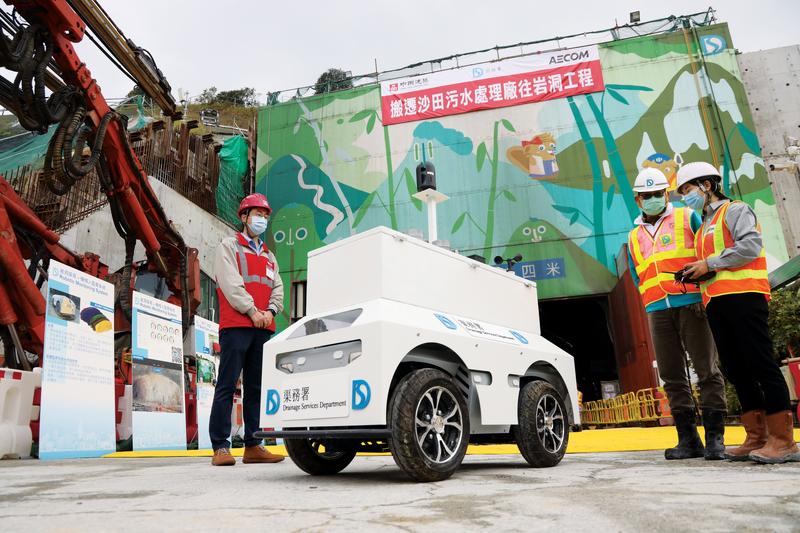Project that moves Shatin treatment facility into caverns will free up space for housing
 From left: Li Yifeng, senior site manager of China State Construction Engineering Corp; Wong yiu-fai, senior geotechnical engineer of the cavern projects division of the Drainage Services Department; and Juling L. Zhu, resident engineer at engineering firm Aecom, demonstrate a car with a robotic monitoring system during a tour comprising visiting engineering experts and representatives from the local media at the Sha Tin Sewage Treatment Works in Sha Tin on Thursday. (EDMOND TANG / CHINA DAILY)
From left: Li Yifeng, senior site manager of China State Construction Engineering Corp; Wong yiu-fai, senior geotechnical engineer of the cavern projects division of the Drainage Services Department; and Juling L. Zhu, resident engineer at engineering firm Aecom, demonstrate a car with a robotic monitoring system during a tour comprising visiting engineering experts and representatives from the local media at the Sha Tin Sewage Treatment Works in Sha Tin on Thursday. (EDMOND TANG / CHINA DAILY)
Experts and residents hailed the project of relocating the existing Shatin sewage treatment plant to caverns as “green” and “safe”, as the project adopted cutting-edge technologies to ensure construction safety and minimize the impact on the environment and nearby communities.
The relocation project, proposed by the Hong Kong Special Administrative Region government in 2013 to solve the city’s acute landshortage issue, plans to put the 28-hectare sewage treatment plant in Ma Liu Shui, Sha Tin, into caverns in nearby Nui Po Shan.
After relocation, the new 14-hectare plant in caverns is expected to be the largest cavern project in Asia. It will start operation in 2029.
The old site will be converted into housing and other functions that will improve people’s livelihoods.
“Facing such a mega project, the engineering teams made tons of efforts to ensure the construction is safe, environmentally friendly, and to promote the city’s sustainable development,” said Li Yifeng, senior site manager of China State Construction Engineering (Hong Kong), which is responsible for the project, on Tuesday during a media tour.
The tour is one of a series of events featuring China’s engineering prowess.
China State Construction Engineering (Hong Kong), together with the Drainage Services Department and consultant companies, is mainly responsible for the construction of the first two phases of the cavern sewage treatment plant.
The site preparation and access tunnel construction work of Phase One began in February 2019 and is targeted for completion in 2022, while the main cavern’s construction work of phase two started in July.
After the existing open-air plant is relocated into caverns, each cavern will serve as a natural barrier, fully enclosing the facility.
The main cavern’s construction work needs engineering teams to excavate 11 caverns for a sewage treatment facility, and the whole cavern complex is 2.3 million cubic meters.
The caverns, with a maximum cross-sectional area of over 900 square meters, will be excavated by a drilling and blasting method, Li said.
“We are proactively exploring high-technology solutions to address difficult problems, and we aim to promote the application of smart construction sites and create demonstration projects for technological innovation,” Li said.
The construction site is the first with 5G in Hong Kong. Numerous industrial sensors and internet of things equipment were installed on-site to improve the efficiency of the surveying and engineering teams, and to reduce the safety risks of workers in hazardous environments.
The equipment can monitor the impact of construction, including groundwater level, blasting vibration, noise, and tunnel air quality in real time, as well as construction activity data, including geology, drilling, electricity use, rock bolt loading and even worker positioning.
The engineering team also developed their own robotic monitoring system in a bid to ensure site workers’ safety.
In addition, Li said that the site teams adopted multiple ways, such as installing noise barriers, blasting doors, and using site IoT monitoring systems to minimize the impact of construction on nearby residents.
Tony Leung Ka-chung, chief engineer (cavern projects) of the Drainage Services Department, said the relocation project will benefit nearby residents and will have a positive influence on Sha Tin and the surrounding environment.
Hong Kong resident Tsang Chuen-ming, who lives around 900 meters from the existing Sha Tin sewage treatment plant, on Tuesday said he supports the relocation project, adding he believes that the project will give nearby residents a better living environment.
“Sometimes I can even smell the odor produced by the sewage treatment plant at home,” Tsang said. “I hope the problem will be addressed after the new plant is put into use.”
Tsang said at the start when he heard that the construction project would require blasting, he was worried about safety and excessive noise. “But now I don’t worry at all,” he said. “I haven’t heard any noise.”
Currently, the plant serves a population of 650,000 in the Sha Tin and Ma On Shan districts, which produces 260,000 cubic meters of sewage per day.


